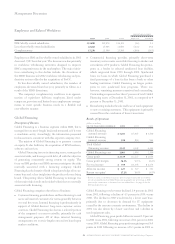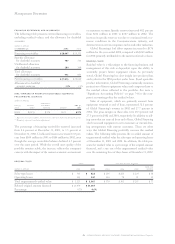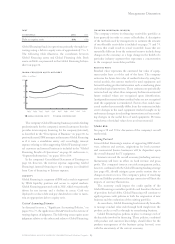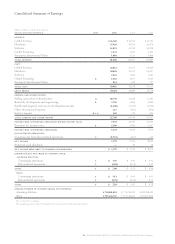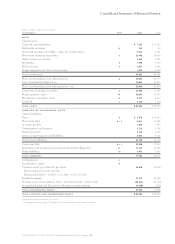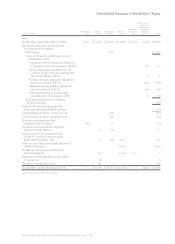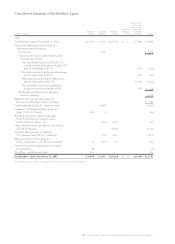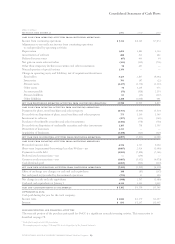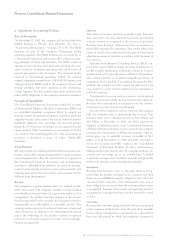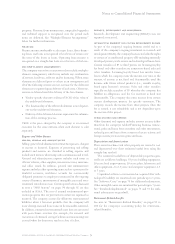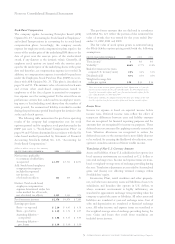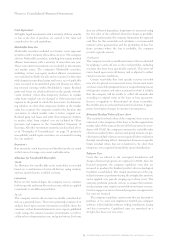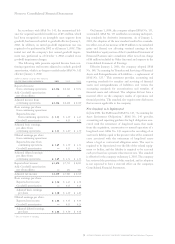IBM 2002 Annual Report Download - page 72
Download and view the complete annual report
Please find page 72 of the 2002 IBM annual report below. You can navigate through the pages in the report by either clicking on the pages listed below, or by using the keyword search tool below to find specific information within the annual report.
Notes to Consolidated Financial Statements
70 international business machines corporation and Subsidiary Companies
aSignificant Accounting Policies
Basis of Presentation
On December 31, 2002, the company sold its hard disk drive
(HDD) business to Hitachi, Ltd. (Hitachi). See note c,
“Acquisitions/Divestitures,” on pages 78 to 80. The HDD
business was part of the company’s Technology Group
reporting segment. The HDD business was accounted for as
a discontinued operation under generally accepted account-
ing principles (GAAP) and therefore, the HDD results of
operations and cash flows have been removed from the com-
pany’s results of continuing operations and cash flows for all
periods presented in this document. The financial results
reported as discontinued operations include the external
original equipment manufacturer (OEM) HDD business and
charges related to HDDs used in the company’s eServer and
Storage products that were reported in the Technology
Group segment. The discontinued operations results do not
reflect HDD shipments to the company’s internal customers.
Principles of Consolidation
The Consolidated Financial Statements include the accounts
of International Business Machines Corporation (IBM) and
its controlled subsidiary companies, which in general are
majority owned. Investments in business entities in which the
company does not have control, but has the ability to exercise
significant influence over operating and financial policies
(generally 20-50 percent ownership), are accounted for by the
equity method. Other investments are accounted for by the
cost method. The accounting policy for other investments in
securities is described on page 74 within “Marketable
Securities.”
Use of Estimates
The preparation of Consolidated Financial Statements in con-
formity with GAAP requires management to make estimates
and assumptions that affect the amounts that are reported in
the Consolidated Financial Statements and accompanying
disclosures. Although these estimates are based on manage-
ment’s best knowledge of current events and actions that the
company may undertake in the future, actual results may be
different from the estimates.
Revenue
The company recognizes revenue when it is realized or real-
izable and earned. The company considers revenue realized
or realizable and earned when it has persuasive evidence of an
arrangement, the product has been shipped or the services
have been provided to the customer, the sales price is fixed or
determinable and collectibility is reasonably assured. The
company reduces revenue for estimated customer returns and
other allowances. In addition to the aforementioned general
policy, the following are the specific revenue recognition
policies for each major category of revenue and for multiple-
element arrangements.
services
The terms of services contracts generally range from less
than one year to ten years. Revenue from time and material
services contracts is recognized as the services are provided.
Revenue from Strategic Outsourcing Services contracts in
which IBM manages the customer’s data center reflects the
extent of actual services delivered in the period, based upon
objective measures of output in accordance with the terms of
the contract.
Revenue from Business Consulting Services (BCS) con-
tracts that require IBM to design, develop, manufacture or
modify complex information technology systems to a buyer’s
specifications, and to provide services related to the perform-
ance of such contracts, is recognized using the percentage of
completion (POC) method of accounting. In using the POC
method, the company records revenue by reference to the
costs incurred to date and the estimated costs remaining to
fulfill the contracts.
Provisions for losses on services contracts are recognized
during the period in which the loss first becomes apparent.
Revenue from maintenance is recognized over the contrac-
tual period or as the services are performed.
In some of the company’s services contracts, the company
bills the customer prior to performing the services. This
situation gives rise to deferred income of $2.6 billion and
$2.4 billion at December 31, 2002 and 2001, respectively,
reported as Deferred income in the Consolidated Statement
of Financial Position. In other services contracts, the company
performs the services prior to billing the customer. This sit-
uation gives rise to unbilled accounts receivable of $1.3
billion at both December 31, 2002 and 2001, recorded as
Notes and accounts receivable
—
trade in the Consolidated
Statement of Financial Position. In these circumstances,
billings usually occur shortly after the company performs the
services and can range up to six months later. Unbilled
receivables are expected to be billed and collected generally
within four months, rarely exceeding nine months.
hardware
Revenue from hardware sales or sales-type leases is recog-
nized when the product is shipped to the customer and when
there are no unfulfilled company obligations that affect the
customer’s final acceptance of the arrangement. Any cost of
these obligations is accrued when the corresponding revenue
is recognized. Revenue from rentals and operating leases is
recognized on a straight-line basis over the term of the rental
or lease.
software
Revenue from one-time charge licensed software is recognized
at the inception of the license term. Revenue from monthly
license charge arrangements is recognized on a subscription
basis over the period in which the enterprise is using the


